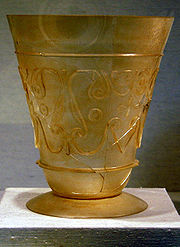
Beaker (archaeology)
Encyclopedia

Claw beaker
A claw beaker is a name given by archaeologists to a type of drinking vessel often found as a grave good in 6th and 7th century AD Frankish and Anglo-Saxon burials....
and the rough-cast beaker, however when used alone the term usually refers to the pottery cups associated with the European Beaker culture
Beaker culture
The Bell-Beaker culture , ca. 2400 – 1800 BC, is the term for a widely scattered cultural phenomenon of prehistoric western Europe starting in the late Neolithic or Chalcolithic running into the early Bronze Age...
of the late Neolithic
Neolithic
The Neolithic Age, Era, or Period, or New Stone Age, was a period in the development of human technology, beginning about 9500 BC in some parts of the Middle East, and later in other parts of the world. It is traditionally considered as the last part of the Stone Age...
and early Bronze Age
Bronze Age
The Bronze Age is a period characterized by the use of copper and its alloy bronze as the chief hard materials in the manufacture of some implements and weapons. Chronologically, it stands between the Stone Age and Iron Age...
.
This type of beaker was first defined by
Lord Abercromby
John Abercromby, 5th Baron Abercromby
John Abercromby, 5th Baron Abercromby was a Scottish soldier and archaeologist. The second son of the George Abercromby, 3rd Baron Abercromby and Louisa Penuel Forbes, on his death in 1924 he had no male issue and as a result the Barony Abercromby became extinct.-Career:He was a Lieutenant with...
in the early twentieth century and comes in three distinct forms, the bell beaker and the rarer short-necked and long-necked beakers although there are many variations on these basic types.
Bell beakers appear to be the earliest type and are often covered with decoration made from impressing twisted cord into the unfired clay. When the decoration covers the whole vessel they are known as all-over corded (AOC) beakers. Where comb designs are used, perhaps along with cord impressions they are called all-over ornamented (AOO) beakers. Some have a looped handle on one side or a white coloured material pressed into the decoration, contrasting with the orange or brown ceramic.
Traditionally they were superseded by the short-necked beakers which in turn were replaced by long-necked forms. Work by Humphrey Case in the 1990s has suggested that the three styles were used contemporaneously for different purposes.
Beakers have been found from North Africa to southern Scotland and from Portugal to the far east of Europe but is particularly common in the Rhine valley and the coasts of the North Sea
North Sea
In the southwest, beyond the Straits of Dover, the North Sea becomes the English Channel connecting to the Atlantic Ocean. In the east, it connects to the Baltic Sea via the Skagerrak and Kattegat, narrow straits that separate Denmark from Norway and Sweden respectively...
.
Source
- Oxford Concise Dictionary of Archaeology, Darvill, TTim DarvillTimothy Darvill is an English archaeologist and author, best known for his publications on prehistoric Britain and his excavations in England, Wales, and the Isle of Man. He is Professor of Archaeology in the School of Applied Sciences at Bournemouth University in England. Timothy Darvill is...
, OUP, 2003
Yhu Have 2 Use A Microscope Device Used To Trap Insects

